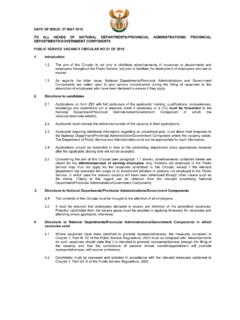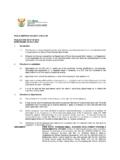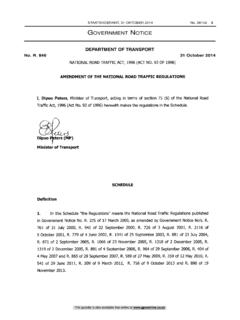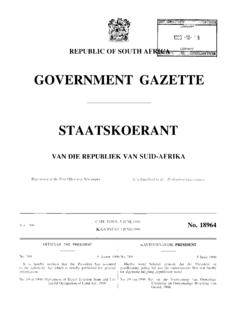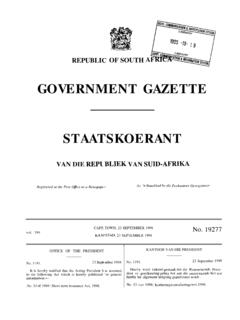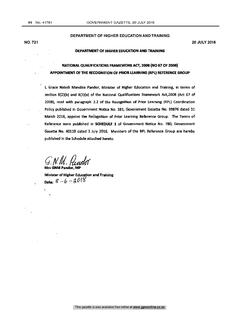Transcription of Industrial Policy Action Plan IPAP 2018/19-2020/21 - Gov
1 The dti | IPAP: 2018/19 2020/21 1 the dti Campus 77 Meintjies Street Sunnyside Pretoria, 0002 the dti Postal Address Private Bag X84, Pretoria, Gauteng, 0001 the dti Customer Contact Centre: 0861 843 384 Courier the dti, 12 Robert Sobukwe St, Sunnyside, Pretoria, Gauteng, 0002 the dti Website: ISBN: 978-0-621-46268-5 RP: 109/2018 the dti | IPAP: 2018/19 2020/21 2.
2 3 .. 8 .. 11 .. 33 .. 55 .. 61 .. 62 .. 71 .. 73 .. 85 .. 91 .. 93 .. 111 .. 112 .. 115 .. 121 .. 127 .. 134 .. 141 .. 160 .. 161 .. 170 9.. 176 .. 179 11.. 183 12.. 191 the dti | IPAP: 2018/19 2020/21 3 his is the tenth annual iteration of the Industrial Policy Action plan (IPAP) and the last of the present administration. In addition to providing an economic analysis of prevailing global and domestic economic conditions relevant to Industrial Policy ; time bound Action plans and programmes across a range of sectors and listing the key constraints to an optimal Industrial strategy, IPAP 2018 provides a summarised Legacy Report covering progress over the ten years of its existence.
3 The occasion also gives us a useful opportunity to reflect on the implementation of IPAP in the period since the adoption of the National Industrial Policy Framework (NIPF) and the experience of implementing successive, updated Action Plans over the course of one decade. Industrial Policy has the over-arching objective of enhancing the productive capabilities of the economy. In other words, Industrial Policy aims to increase the economy s ability to produce more and more complex and high value-added products with greater efficiency.
4 In simple terms, this means to produce more value using less resources. Building the economy s Industrial capabilities is a continuous and long-term endeavour and technologies continuously evolve. 1 Other criteria: Provides strategic and operational leadership to the business; Is entrepreneurial and takes personal risk in the business; Does business in manufacturing and related sectors, with particular reference to IPAP and IDC focus areas; Makes a long-term commitment to the business and is not a short- to medium-term investor.
5 The key challenge to Industrial Policy is to incentivise investment in plant, technologies and skills that would have medium to long term benefits to the economy, but which the market would screen out because there is lower hanging fruit for short term returns. Industrial investment in targeted technologies and sectors spills over to the rest of the economy, resulting in generalised productivity improvement and increased welfare. Industrial Policy has traditionally placed a strong emphasis on the manufacturing sector, precisely because of such spill-over effects, and in terms of production disciplines, the mastery of new technologies and ultimately design capabilities.
6 However, the boundary between what were historically considered primary sectors, such as mining and agriculture, and manufacturing industries and the services sectors, is becoming increasingly blurred. For example, the process of producing high-value agricultural produce on large scale for exports has become extremely technologically complex; more so than some manufacturing processes. Similarly, the mechanisation and digitisation of deep-level and above-ground mining processes require the mastery of complex Industrial capabilities, including many technologies and disciplines associated with the digital Industrial revolution.
7 In a nutshell, many primary sectors have become industrialised, and with time this will become even more the case. In addition, core to South Africa s Industrial Policy is the objective of transforming the racially skewed ownership, management and employment profile of the economy. The synergies between Industrial Policy and transformation are obvious. If a product is imported, there is no possibility of building a transformed supply chain. Industrial Policy needs to make a concerted effort to ensure that support for investment is integrated with support for transformation.
8 For example, the Black Industrialist Programme provides significant grant finance for investment in new plant, provided that the enterprise has at least a 50% black shareholding and/or exercises control over the In addition, then, to these matters of context, the following observations are critical, in our view, to the future of a successful domestic Industrial strategy. T the dti | IPAP: 2018/19 2020/21 4 Basic economic service delivery Firstly, basic economic service delivery needs to be in place for there to be effective Industrial Policy : As is now very widely accepted, the institutional failure that derives from pervasive corruption and rent-seeking in key SOCs must be rooted out from top to bottom.
9 On the supply side, SOCs must play a key enabling role in support of the general economic and Industrial effort by providing competitive and efficient electricity, rail and port logistics. On the demand side, they must support localisation, supplier development and black economic empowerment. Urgent attention must be given to the institutional renewal of public-sector monopolies which have been responsible for significant import leakages, debilitating and unsustainable increases in electricity, rail and port costs and attendant inefficiencies.
10 Institutional coordination The realities of institutional coordination need to be carefully considered. Industrial Policy rests on multiple foundations and must embrace a complex set of interlocking and mutually supportive policies and programmes, held together by the vision set out in the National Development plan . On the one hand, Industrial Policy must be a Policy of the whole of government and not just one or two departments. Policy coherence and programme alignment are a precondition for successful Industrial interventions.
